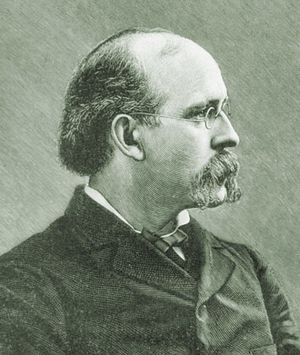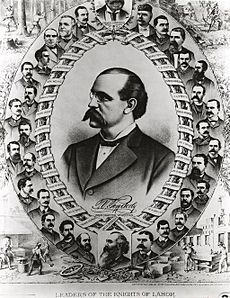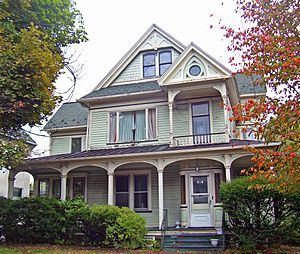Terence V. Powderly facts for kids
Quick facts for kids
Terence Vincent Powderly
|
|
|---|---|
 |
|
| 5th Mayor of Scranton | |
| In office 1878–1884 |
|
| Preceded by | Robert H. McKune |
| Succeeded by | Francis A. Beamish |
| Personal details | |
| Born | January 22, 1849 Carbondale, Pennsylvania, U.S. |
| Died | June 24, 1924 (aged 75) Petworth, Washington, D.C., U.S. |
| Resting place | Rock Creek Cemetery Washington, D.C., U.S. |
| Political party | Greenback-Labor Party |
| Spouses |
Hannah
(m. 1872; died 1907)Emma Fickenscher
(m. 1919) |
| Residences | Scranton, Pennsylvania, U.S. |
| Occupation | Leader of the Knights of Labor (1879–1893) |
| Signature |  |
Terence Vincent Powderly (born January 22, 1849 – died June 24, 1924) was an important American leader for workers. He was a labor union leader, a politician, and a lawyer. He is most famous for leading the Knights of Labor in the late 1800s.
Powderly was born in Carbondale, Pennsylvania. He later became the mayor of Scranton, Pennsylvania, serving three terms starting in 1878. As a Republican, he also worked for the U.S. government as the Commissioner General of Immigration in 1897.
The Knights of Labor was one of the biggest worker organizations in the 1800s. Powderly believed the Knights should help working people learn and grow. He often warned against using strikes to reach goals. His ideas helped create laws about foreign workers and set up labor offices in many states.
The Knights of Labor lost many members after being blamed for the violence of the Haymarket affair in 1886. Another group, the American Federation of Labor (AFL), then became more popular. The AFL focused on skilled workers, while the Knights included all kinds of workers.
Contents
Early Life and Work
Terence Powderly was born on January 22, 1849. He was the 11th of 12 children. His parents were Irish immigrants who came to the United States in 1827. As a child, he got sick with measles and scarlet fever. These illnesses caused him to lose hearing in one ear.
When he was 13, Powderly started working for the railroad. He began as a switchman, helping to move train tracks. He then became a car examiner and a brakeman. At 17, he started an apprenticeship to become a machinist. This meant he learned a skilled trade by working with an experienced person.
In 1871, Powderly joined a workers' union called the Machinists and Blacksmiths International Union. A year later, he became its secretary, then its president. In 1872, he married Hannah Dever.
After a tough economic time in 1873, Powderly lost his job at the railroad. He was told it was because he was a union president. He then worked odd jobs in Canada for a while. He returned to the U.S. in 1874 and continued his union work.
Leading Scranton
Powderly eventually settled in Scranton, Pennsylvania. He found work as a machinist, installing machines used to process coal. He was fired from this job, but then got it back with the help of William Walker Scranton. He worked there until the company closed in 1877.
In 1878, after some worker strikes and unrest in 1877, Powderly was elected mayor of Scranton. He was part of the Greenback-Labor Party. He served three two-year terms. As mayor, he wanted to create jobs by funding public projects. He quickly made changes to the city's workforce.
Leading the Knights of Labor
Powderly is most famous for leading the Knights of Labor, a large national union for workers. He joined the Knights in 1874. In 1879, he became the Grand Master Workman, which was like being the president. At that time, the Knights had about 10,000 members. He led the group until 1893.
Powderly, like many labor leaders then, did not support the immigration of Chinese workers. He believed they took jobs from American-born workers and lowered wages. He encouraged the Knights of Labor to support the Chinese Exclusion Act. This law stopped Chinese workers from coming to the U.S.
Powderly also worked with religious leaders to help Catholics join unions. The Catholic Church had been against unions because of some of their secret rituals. The Knights of Labor changed their name and removed these rituals in 1882. This made it easier for Catholic workers to join.
Powderly believed in "producerism," which meant that most employers were also "producers" and part of the working class. Because of this, he often disliked worker strikes. He thought strikes could hurt businesses and drive away employers.
Despite his feelings about strikes, Powderly was good at organizing. The Knights of Labor grew very quickly. At one point, they even stopped accepting new groups because they were growing so fast. The union became known as the first successful national labor union in the U.S.
In 1885-1886, the Knights had their biggest influence and most members. Powderly wanted the union to focus on working together and on getting an eight-hour day. But members wanted faster improvements. Businesses and the government also put pressure on the union.
The Knights were not organized enough to deal with big industries. Powderly often stopped strikes that historians believe the workers could have won. For example, he ended strikes against a railroad company and a meatpacking company in 1886. After this, companies were less afraid of the Knights using strikes. This caused the Knights of Labor to start losing its power.
A big problem for the Knights was the Haymarket affair in Chicago in May 1886. This was a violent event where a bomb exploded. Anarchists were blamed, and some of them were members of the Knights. Many people wrongly linked the Knights to anarchism and terrorism. Membership dropped very quickly.
The union also became divided, and its attempts to get involved in politics failed. Powderly did not want members to be too active in politics. Many Knights members left to join other unions, like the American Federation of Labor (AFL). The AFL focused on specific skilled trades, which was different from the Knights' idea of one big union for everyone.
Powderly was not re-elected as Grand Master Workman in 1893. As the Knights continued to decline, Powderly started a successful law practice in 1894. He also supported the idea of a "single tax" on land values, proposed by Henry George.
Later Career
In 1897, President William McKinley appointed Powderly as the Commissioner General of Immigration. He held this job until 1902. In this role, he looked into conditions at Ellis Island, where many immigrants arrived. His work led to some employees being fired.
Even after leaving that main role, he continued to work as a Special Immigration Inspector. He studied why people were leaving Europe to come to the U.S. He suggested that officials should check immigrants before they arrived in the U.S. He also thought officers should be on ships carrying immigrants. He believed immigrants should be spread out more evenly across the country.
Later, Powderly became the chief of a new part of the Immigration Service. Its job was to help immigrants settle in different parts of the United States. In 1921, three years before he died, he joined the Immigration Service's Board of Review.
Death and Legacy
Terence Powderly lived in Petworth, Washington, D.C. in his final years. He died at his home there on June 24, 1924. He is buried at Rock Creek Cemetery nearby. A book about his life, The Path I Trod, was published after his death in 1940.
Powderly's writings and papers are kept in many research libraries across the U.S. He was survived by his second wife, Emma, whom he married in 1919.
In 1999, Powderly was honored by being added to the United States Department of Labor Hall of Honor. Historians like Richard Oestreicher have called Powderly "the first labor leader in American history to become a media superstar."
While some say Powderly failed to keep the Knights of Labor strong, Oestreicher also noted that he was an "energetic and capable organizer." He pointed out that Powderly faced huge challenges. He suggested that no one else did much better in leading labor unions over the next forty years.
In 1966, Powderly's longtime home in Scranton was recognized as a National Historic Landmark. A historical marker honoring Powderly was placed in Scranton in 1947.
Works by Powderly
- "The Organization of Labor," North American Review, 1882.
- "The Army of the Discontented," North American Review, 1885.
- "A Menacing Irruption," North American Review, 1888.
- "The Plea for Eight Hours," North American Review, 1890.
- "The Workingman and Free Silver," North American Review, 1891.
- Thirty Years of Labor, 1859-1889. 1890.
- "Government Ownership of Railways," The Arena, 1892.
- The Path I Trod: The Autobiography of Terence V. Powderly. 1940.
See Also
- James Duncan (union leader)
- Labor unions in the United States
- List of Mayors of Scranton, Pennsylvania
- Rock Springs massacre
- Uriah Smith Stephens



